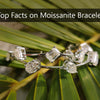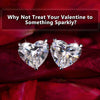
Colorless Moissanite: Everything You Need to Know
Fashion trends are constantly evolving. Every season brings a new style, from sleeveless tops to puff sleeves, office purses to tote bags, and traditional gemstones to moissanite. While clothes and accessories come and go, moissanite has established itself as a permanent name. Moissanite, the fallen star, has been the craze for years. However, despite the buzz and hype surrounding the sustainable, eco-friendly, and wallet-conscious gemstone, there seems to be confusion regarding colorless moissanite and diamond. Contrary to the popular notion, moissanite and diamond are different in their own ways. If you want clarity on the topic, grab a drink, read this guide, and browse Diamondrensu's magnificent collection!
Can Moissanite Pass for Diamond?
The answer to this question is a clear, loud, and resounding "Yes!" Moissanite walks parallel to a diamond in every way. Moissanite meets diamond head-on with its brilliance, color, sparkle, durability, and hardness. The only difference between the two gemstones is their affordability. The decade-old traditional stone, when sourced naturally, breaks the bank.
Given its complex acquisition process, a natural diamond's price is an accumulation of mining equipment, labor, manufacturing, cutting, polishing, production, and retail rates. On the other hand, Moissanite gives your colorless moissanite ring a diamond's radiance barring the extravagant cost.
Besides the price difference, it is easy to pass moissanite for diamonds. The naked eye can't spot the differences between the two. Gemologists either observe moissanite under 10x magnification or use the diamond tester to check moissanite. Moissanite passes the diamond tester, confirming and verifying its authenticity.
Diamond Tester
A diamond tester examines specific moissanite properties and compares them to the diamond's specification to differentiate between the two. The tester studies qualities such as moissanite's color and clarity. Once both color and clarity match those of a diamond, the tester observes moissanite's refractive index. Diamond testers also test a stone's inclusions. Colorless moissanite engagement rings clear the diamond tester on all four grounds: color, clarity, inclusions, and refractive index.
Diamond Tester Criteria
In order to clear a diamond test, gemologists should create the diamond tester with the following specifications in mind to generate relevant results:
- The tester's accuracy rate should be more than 93% and at least 99%. Additionally, the diamond tester should be designed thoroughly and carefully to avoid displaying false positive and negative results.
- The tester should be conducted in a regulated environment to avoid light sensitivity, disturbances, and interruptions in the surroundings, as outside factors can affect the results.
- Diamond testers should check all parameters, such as color, clarity, refraction, and inclusions.
- Gemstones should have their properties tested and certified by official authorities, such as the Gemological Institute of America (GIA) and the International Gemological Institute (IGI).
Moissanite has cleared multiple accurate diamond testers, indicating the stone can pass off as a diamond.
Does Moissanite Look Like a Diamond?
Moissanite's physical and chemical composition resembles a diamond, making it look like a diamond. The untrained eye will not catch the difference unless one checks moissanite under a 10x magnitude. Moissanite is colorless, near colorless, or contains a slight gray, green, or yellow tinge, which is visible when exposed to light. GIA even accredited moissanite as the gemstone closest to a diamond in terms of attributes, properties, and appearance. However, despite being called a 'space diamond' initially, moissanite stands tall in a league of its own.
Even though diamond and moissanite have natural origins, the difference lies in their availability. Natural diamond forms naturally within the Earth's surface, which is why it is abundant and obtained through mining. On the other hand, moissanite or silicon carbide was discovered when a meteor carrying the mineral crashed on Earth in the late 1800s. Given natural moissanite's once-in-a-lifetime occurrence, it is produced artificially in laboratories, making it sustainable and environmentally friendly.
Whether lab-produced or natural, moissanite possesses exceptional durability and aesthetic appeal, making it a sought-out stone for designing jewelry and accessories. Its color, hardness, sparkle, and brilliance are nearly identical to a diamond, making it a consumer-favorite gemstone at an affordable price.
However, unlike diamonds, gemologists do not grade moissanite on the standard diamond grading chart. In order to test moissanite, gemologists use a GIA-approved K-color diamond chart. Unless a gemologist or professional jeweler observes your colorless moissanite ring or you use high-quality technological equipment, learning the color of your jewelry would be challenging.
Even though colored moissanite rings, such as a 4.40 TW Cushion Cyan Blue Halo Set Lovely Moissanite Wedding Pendant, are in high demand, consumers also gravitate toward colorless moissanite rings. Moissanite rings like an Ice Crushed 4.76 CT Radiant Classic Petite Pave Crown Moissanite Wedding Ring or a 3.19 TW Pear with Black Baguette Moissanite Unique Double Halo Ring are trendy because their colorless quality resembles a diamond.
Sometimes, even trained jewelers fail to spot the difference between moissanite and diamonds because, just like the latter, the former also comes in various shapes, sizes, and cuts identical to a diamond. Furthermore, with constant technological innovation and evolution, tools and equipment that are more advanced are being used to manufacture moissanite, enhancing its appearance and composition.
3.19 TW Pear with Black Baguette Moissanite Unique Double Halo Ring
How to Tell Moissanite from Diamond
Trained professionals, such as jewelers, can instantly spot the difference between moissanite and diamond by observing them under 10x magnification. Moissanite has very slight inclusions like a diamond, but its inclusions are not present in diamonds, making it easier to identify the stone.
Brilliance and Refraction
In addition to consulting a gemologist or a trained eye, you can test the similarities between the physical components of moissanite and diamond by keeping the two stones next to each other. Unless you own laboratory equipment, such as a professional magnifier, the chances of finding similarities between the two are low.
However, if you want to try spotting the difference with your naked eye, notice the brilliance of both stones. Despite having a similar fire, the brilliance rate of the two gemstones is still slightly different. Light passing through a diamond stone will not split, regardless of the direction, making it a singly refractive stone. On the flip side, light entering moissanite splits into two rays, giving it a double refractive index. Due to its double refraction, moissanite displays more colors and fire, resembling a rainbow or disco ball.
Using a Diamond Tester
Diamond testers test whether or not a stone is a real diamond by calculating the heat passing through it. Non-moissanite gemstones will have difficulty clearing the test since heat passes through them at a different rate and speed. However, moissanite's heat absorption capacity and ability resemble that of a diamond, identifying it as a diamond. In addition to heat tests, some diamond testers use electricity to check gemstones, but electrical indicators only detect whether a stone carries a diamond's properties and not its name.
Size of the Gemstones
The direct relationship between their size and the colors is a quality that both moissanite and diamond share. The larger the stone, the more color visibility there is, making the differentiation process quicker and easier. Moissanite stones, especially the center stone in colorless moissanite engagement rings, have a specific weight per carat, unlike diamonds. Trainer jewelers or shoppers can notice the difference between the size, color, and weight of the two stones, making it easier to identify them.
Color
Another point of difference between the two stones is their color. Usually, diamonds are pure and glaringly white and colorless. They might come in shades of white, but a diamond is always colorless. On the other hand, moissanite is available in three forms: colorless, near colorless, and in hues of colors, such as cyan blue, yellow, green, or gray.
Durability
Moissanite and diamond rank close on the Mohs hardness scale with a minute difference. Diamond ranks ten on the scale, making it exceptionally hard and durable, whereas moissanite comes second with a hardness of 9.25. Both gemstones are durable and can withstand damage, breaking, wear, and tear, but testing their hardness scale helps differentiate between them.
Price
Since diamonds are sourced naturally, they are generally expensive. On the other hand, even though moissanite rates vary according to the gemstone's cut, carat, color, shape, and size, the final price will always be more reasonable than a diamond.
Indices
Diamonds have higher indices than moissanite. Due to fewer indices, moissanite is lightweight, which might not be noticeable initially, but will show up in the diamond tester.
External Factors
External factors also help in identifying and differentiating between a diamond and moissanite. A diamond's surface becomes dehydrated when exposed to low temperatures and highly humid environments for a more extended period. Alternatively, moissanite shows a different reaction under cooler temperatures and in highly damp areas. Unlike diamond, which takes days or weeks to dehydrate, moissanite's surface instantly becomes dehydrated.
4.40 TW Cushion Cyan Blue Halo Set Lovely Moissanite Wedding Pendant
In Conclusion
Colorless moissanite is not a mere alternative to diamond; instead, it is an equally stunning and more financially feasible gemstone. Unless you own professional equipment or ask a jeweler, you will not be able to spot the difference between them. If you want to own a gorgeous piece of jewelry without worrying about your bank balance, check out and shop from Diamondrensu's diverse catalog from the comfort of your home!
Leave a comment
Please note, comments must be approved before they are published.












